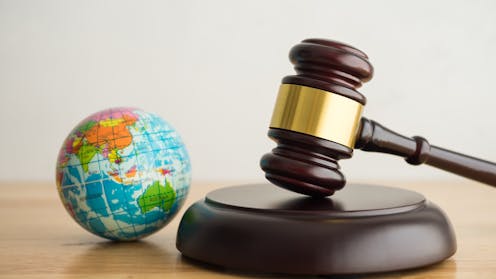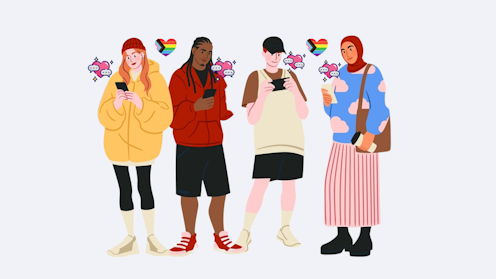Source: The Conversation – UK – By Mark Westgarth, Professor, History of the Art Market, University of Leeds

A juvenile dinosaur fossil, Ceratosaurus nasicornis, has sold at Sotheby’s New York for US$30.5 million (£22.7 million). It is part of a recent resurgence of art-market interest in fossils and natural history – palaeontology and geology especially. Indeed, this latest dinosaur sale was part of an auction specifically dedicated to natural history.
Led by iconic Tyrannosaurus Rex fossils, the prices for such specimens have reached eyewatering levels in recent years. “Stan”, currently the most expensive T-Rex, sold for US$31.8 million at Christie’s New York in 2020. Then a stegosaurus called “Apex” sold for US$44.6 million in New York in 2024.
The US$30.5 million sale of the juvenile Ceratosaurus, a much smaller species, raises the market bar significantly. Even a T-Rex fossil foot at the latest Sotheby’s auction far exceeded its published estimate of US$250,000-US$300,000, selling for US$1.8 million. When you reflect that a full T-Rex fossil by the name of “Sue” sold for US$8.4 million in 1997 – US$17 million in today’s money – it looks cheap by comparison.
Sotheby’s marketing of the Ceratosaurus highlights how the art market builds narratives around these objects of science. Publicity photographs emphasise the dinosaur’s sculptural qualities, along with descriptions like “mounted in an action pose … with jaws open”. This mirrors the presentation in taxidermy mounts, another market that is drawing in more collectors at present.
Photographs in the auction publicity have an almost filmic quality. They tie the fossil to its discovery process, with the image at the top of this article including an SUV in the distance that is kitted out for fossil hunting.
The extensive catalogue description builds on this, appropriating the language of science with a forensic account of how the fossil was discovered and pieced together, supporting the key art market criteria of authenticity.
It highlights the commodity status of the fossil as a spectacle, aimed at new, younger super-rich collectors who are seeking out statement pieces. These allow them to demonstrate what the French sociologist Pierre Bourdieu termed increasing levels of distinction – in other words, cultural choices as markers of status and power.
Auctions and ethics
Some palaeontologists express concerns about the idea of moving dinosaur remains “into the same realms as fine art”. Much opposition comes from the Society of Vertebrate Palaeontology (SVP), a leading body on fossil research based in Utah, which is influential far beyond the US.
Stuart Sumida, the president of the society, complained after the Ceratosaurus auction that such transactions can mean removing specimens “from the public trust and the scientific community for profit”. As his predecessor David Polly lamented in 2018, it can “create a perception that [fossils] have a commercial value”.
The premise here is that the market is somehow dislocated from palaeontology, but the truth is that scientific research is never conducted in a commercial vacuum. It benefits from private funding and publishes in journals whose access is restricted for commercial gain. Replicas of dinosaur specimens are commercially licensed by museums, while moving fossils or replicas between institutions involves huge costs, covering everything from transport to insurance.
Equally, the relationship between palaeontology and the market is more symbiotic than it might appear. The market for dinosaur fossils traces back to the late 18th century, with early operators including the fossil collector Mary Anning (1799-1847). Her discovery of dinosaur fossils on the English south coast in Dorset led to her establishing a successful shop called Annings Fossil Depot in the mid-1820s.
Now recognised as one of the leading palaeontologists of the 19th century, the market for fossils that she helped to create increased the visibility and public interest in dinosaurs. This in turn acted as a catalyst for increased research activity in this area.
More recently, the appetite for dinosaurs is reflected in multiple consumer spheres, from Jurassic Park to Barney & Friends. Every new product boosts public awareness of dinosaurs and no doubt ignites further research activity.

Paul M Walsh
Each dinosaur auction that hits the headlines contributes to this effect. Privately owned fossils are also, in my experience, more likely to be exhibited in venues beyond natural history museums, such as major art fairs and even contemporary art museums. This too increases their visibility, which probably helps expand the range and scope of research interest.
Now, you might argue that public interest is strong enough to drive research without the need for any benefits from auctions. Maybe the benefits are also outweighed by the palaeontologists’ concerns about specimens being lost to science when they fall into private hands.
Then again, the SVP’s ethical guidelines contribute to such marginalisation. These insist that palaeontologists should “only conduct research on fossils held in collections with a permanent commitment to curation and accessibility” – in other words, museums. Loosen this restriction and the objection diminishes.
When bodies like the SVP call for a total separation between art and science, between research and the art market, maybe they’re the ones that are the dinosaura for taking such a simplistic approach. The reality of auctioning these discoveries is a lot more complicated than some would have you believe.
![]()
Mark Westgarth receives funding from Arts & Humanities Research Council.
– ref. Why it’s not a problem that dinosaurs are sold for millions of dollars – art historian – https://theconversation.com/why-its-not-a-problem-that-dinosaurs-are-sold-for-millions-of-dollars-art-historian-261542






